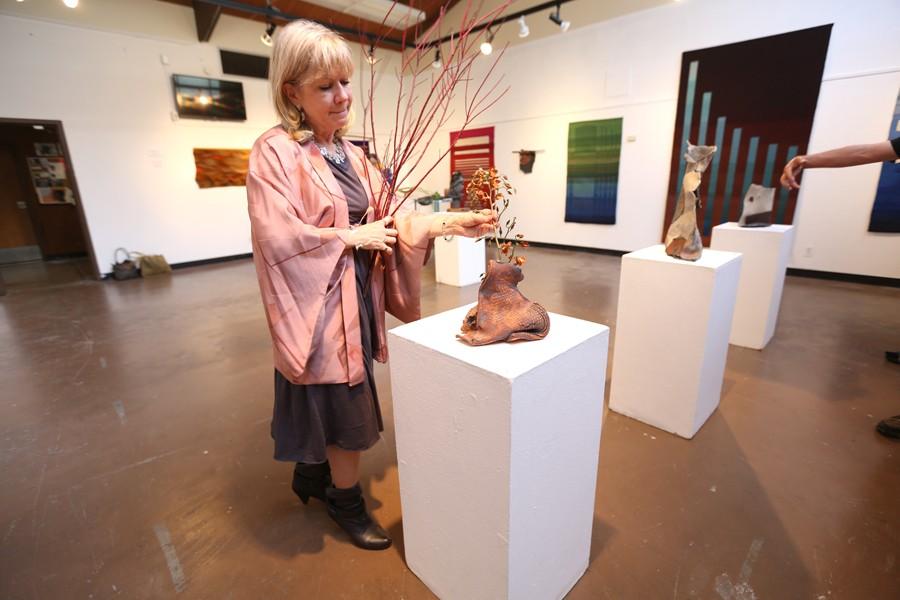Gallery highlights artists
Ceramic, woven artworks grace Eddie Rhodes
Barbara Stevens Strauss combines ceramic sculpture with organic arrangements during the “Texture Times Two” artist reception held Thursday in the Eddie Rhodes Gallery.
Mar 18, 2015
The Eddie Rhodes Gallery is hosting the works of two very different artists in its current exhibit, “Texture Times Two.”
The artists’ reception was held March 12 from 4-7 p.m., where students and other guests of the gallery had a chance to meet the sculptor and weaver responsible for the eclectic exhibit.
The gallery featured the works of two artists, weaver Maj-Britt Mobrand and sculptor Barbara Stevens Strauss.
The center of the room held Strauss’ sculptures that involved flower arrangements and the walls were covered with Mobrand’s wide-ranging woven art.
“Once I started hanging it I thought, ‘Wow! The balance between strength, grace and beauty is wonderful,” adjunct fine art professor Dana Davis, who curates the gallery, said.
This particular show will be up until March 26.
Its hours vary by day: Monday through Thursday and Saturdays from 10 a.m.-3 p.m., and Thursday evenings from 6:30-8:30 p.m. Faculty within the Art Building can be asked to open the gallery for viewers, Davis said.
Mobrand said she has been weaving since her grandmother taught her as a young girl. She continued to weave throughout her life as her passion grew.
Her friend and guest of the gallery, Inger Troy, said, “I’ve seen her pieces develop and get better.”
Mobrand’s pieces included a few different kinds of weavings such as Navajo wedge weaving, which she likes because of the texture it gives her pieces. She drew inspiration from the materials used in her work, things she liked and everyday moments.
Another one of her pieces, titled “Watermelon Man,” was inspired by a watercolor painting made by her granddaughter, which she then recreated with yarn.
The quilts are more contemporary and vibrant than traditional weavings, Davis said.
Decked out in a full kimono, Strauss displayed her love for Japanese culture by putting together her Raku themed sculptures with the art of Japanese flower arranging, called Ikebana, which she has been practicing for over 10 years.
“By putting flowers in Raku movement, it extends the design line,” Patricia Bengston, friend of both artists and gallery guest, said. “The flowers and wool are soft and complement each other — they are in harmony.”
Strauss said she is very spontaneous with her sculptures and for the most part does not take more than a couple of hours on each.
Three-dimensional art became a great interest of hers because the sense of how to place things is appealing, she said.
She considers Eastern art to be less aesthetic than that of Western culture and the simplicity and beauty of it captivated her.
Ikebana is what Strauss calls “a living culture,” which focuses on design. It is structural not functional and including it in her pieces helps to bring them to life, she said.
Although her heritage is not Japanese, Strauss said that she is Japanese on the inside, and the art has helped her connect more to the culture.
“You can bridge cultures with an understanding of art,” she said.


